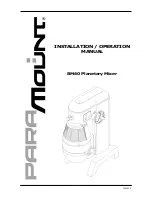
16
PA-CP
User Guide
AUX SENDS
The
PA Series
has four auxiliary sends.
These provide independent mixes from the channels. They
have many applications, the most common being foldback
monitor and effects sends. They can also be used for
additional special feeds such as recording or clean feed.
FB1
Pre-fade aux send feeding the FB1 foldback monitor
output. Turn up the control to send the channel signal to the
mix, from fully off to a m6dB boost. The unity 0dB
position is indicated. The send is pre-fader but post-EQ and
post-mute. This means that its level is not affected by the
channel fader but it is affected by any changes made to the
EQ. Pressing MUTE also turns off the FB1 send.
FB2
Pre-fade aux send feeding the FB2 foldback monitor
output. Similar to FB1 described above.
AUX
Post-fade aux send feeding the AUX output socket.
The AUX send is affected by the channel fader. The AUX mix
can be used for a variety of applications such as additional
effects send, independent speaker zone or recording feed.
FX
Post-fade aux send to the internal effects unit and also the
FX output socket. Turn up the control to feed a portion of the
channel signal to the effects unit where it is processed to create
effects such as reverb and delay. The FX sends let you adjust
how much effect you add to each signal in the mix.
Aux sends
are referred to as ‘pre-fade’ or ‘post-fade’.
This is because the signal that is routed to the send control is
sourced before (pre) or after (post) the channel fader. This is
illustrated in the BLOCK DIAGRAM in the Specification section
later in this user guide.
Effects sends
are used to add effects such as
electronically simulated reverb or echo to the mix. Turning up
the FX control sends a portion of the channel signal to the
internal effects unit where it is processed before being returned
to the main mix through the FX channel. The processed ‘wet’
signal adds to the direct ‘dry’ signal in the same way as the
listener would hear a direct sound followed by natural room
reverberation. The FX send is post-fader to ensure that the
balance between direct and effect signal is always the same
regardless of fader position.
☺
Using more than one effects unit
Use the AUX send to
feed another effects processor in addition to the internal effects
unit. You can also use the FX output with an external unit
instead of or mixing with the internal unit.
Foldback sends
are used to provide individual or
groups of performers or backstage crew with their own monitor
mix, for example wedge speakers facing musicians on stage,
in-ear monitors, hotspot speakers, dressing room and lighting
position feeds. The mix is created by turning up the channel
FB sends according to the needs of the performers. It is not
affected by the faders which control what the audience hears.
☺
Setting up a foldback monitor mix
Start with all the
channel sends turned fully down. Gradually turn up the sends
to add those sounds requested by the performers, typically the
vocals and a few lead instruments. Normal control position is
around 9 to 3’o’clock according to strength in the mix. Be
careful to avoid feedback between closely positioned mics and
speakers. Only add those sounds which are needed or
requested. Keep the mix as simple as possible and try to avoid
adding effects such as reverb which can muddy the sound on
stage and reduce the gain before feedback.
O
FB2
O
FB1
+6
O
O
AUX
O
O
+6
+6
=
O
PAN
O
+6
R
L
PK !
















































